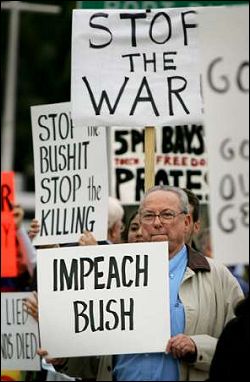Massachusetts conservatives go on witch hunt
History of the Bill of Address from the Alliance's website:
The bill of address process to remove judges under the Massachusetts Constitution has an interesting history. It has been successfully used six times (twice for two judges at the same time). In addition, three judges resigned after a bill of address process was begun against them. Over the years, one Supreme Judicial Court justice has been removed (1803) and an attempt was made against another (1922).
The last successful removal of a judge was in 1973. The most recent use of the bill of address was in 2001, against Judge Maria I. Lopez. In the Lopez case, a bill of address was filed and sent to the Judiciary Committee but she resigned before hearings commenced.
The bill of address is a two-step process. The legislature (by a majority vote in both houses) must ask the governor to remove the judge. Then the governor and governor's council must officially concur, and the judge is immediately removed.
Most of the bill of address actions are initiated by the legislature, but in one case (1978) the governor initiated it by calling a special session of the legislature. (The judge resigned after the process began.)
During the 1850s the legislature successfully passed a bill of address against the same judge three times. The first two times the governor refused to remove him. So they waited for a new governor, and it was successful the third time.
No reasons for the requested removal need be stated in a bill of address. Research has uncovered the actual reasons to include not only outrageous rulings and actions from the bench, but also extortion, senility, participation in a rebellion, bribery, lying under oath, and other offenses.
Bill of Address Actions in Massachusetts
1787
William Whiting, First Justice of the Court of Common Pleas
and
James Perry, a Bristol County Justice of the Peace
(Both addressed and removed)
1803
Justice Theophilus Bradbury of the Supreme Judicial Court
(Addressed and removed)
1803
Judge Paul Sargent of the Court of Sessions
and
Judge William Vinal of the Court of Common Pleas
(Both judges were addressed and removed)
1855
Judge Edward G. Loring of the Suffolk County Probate Court
(Addressed, but Governor refused to remove)
1856
Judge Edward G. Loring of the Suffolk County Probate Court
(Addressed, but Governor refused to remove)
1858
Judge Edward G. Loring of the Suffolk County Probate Court
(Addressed and removed by new Governor)
1881
Judge Joseph Day of the Barnstable County Probate Court
(Proposed address rejected by legislative committee)
1882
Judge Joseph Day of the Barnstable County Probate Court
(Addressed and removed)
1922
Judge Edward Pierce of the Supreme Judicial Court
(Proposed address rejected by legislative committee)
1952
Judge Ruby
(Resigned before commencement of removal hearings)
1965
Judge Richard K. Gordon of the Third District Court of Essex
(Resigned after petition for address filed)
1972
Judge Vincent Brogna
(Proposed address rejected by legislative committee)
1973
Judge Jerome P. Troy of the Dorchester Municipal Court
(Addressed and removed**)
1978
Judge Robert Bonin, Chief Justice of the Superior Court
(Governor convened special session of legislature to consider address; address approved by legislative committee and Senate; Bonin resigned before consideration by House)
2001
Judge Maria I. Lopez of the Superior Court
(Resigned before commencement of removal hearings)
**The Supreme Judicial Court had disbarred Justice Troy and had enjoined him from performing duties as a judge. But he refused to resign, claiming the court did not have the authority to remove him. So the legislature and governor subsequently removed him through a bill of address.





<< Home